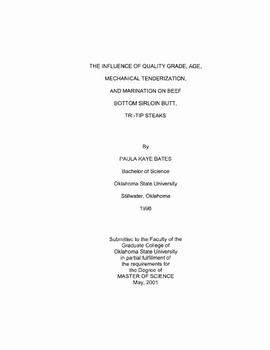| dc.contributor.author | Bates, Paula Kaye | |
| dc.date.accessioned | 2014-09-18T14:41:28Z | |
| dc.date.available | 2014-09-18T14:41:28Z | |
| dc.date.issued | 2001-05-01 | |
| dc.identifier.uri | https://hdl.handle.net/11244/10919 | |
| dc.description.abstract | In general, marination and mechanical tenderization work by disrupting connective tissue, and as a result, increasing tenderness. Considering the challenges faced by the beef industry relative to the consistency of beef palatability, it is postulated that mechanical tenderization coupled with marination can further reduce the variability associated with tenderness. The following research was conducted to 1) investigate the impact of USDA quality grade on bottom sirloin butt steaks as well as, 2) assess how great a contribution various postmortem improvement techniques (aging, mechanical tenderization and marination) have on reducing the variability of bottom sirloin steaks. | |
| dc.format | application/pdf | |
| dc.language | en_US | |
| dc.publisher | Oklahoma State University | |
| dc.rights | Copyright is held by the author who has granted the Oklahoma State University Library the non-exclusive right to share this material in its institutional repository. Contact Digital Library Services at lib-dls@okstate.edu or 405-744-9161 for the permission policy on the use, reproduction or distribution of this material. | |
| dc.title | Influence Of Quality Grade, Age, Mechanical Tenderization, And Marination On Beef Bottom Sirloin Butt, Tri-Tip Steaks | |
| dc.type | text | |
| osu.filename | Thesis-2001-B329i.pdf | |
| osu.accesstype | Open Access | |
| dc.type.genre | Thesis | |
